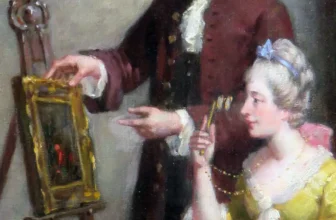What to Do If Your Antique Painting Is Damaged During Shipping
How to Handle and Save Your Antique Painting After Shipping Damage
Shipping an antique painting can be nerve-wracking. These precious pieces of art often hold immense monetary and sentimental value, and even with careful packaging, accidents can happen. Whether you’re a collector, gallery owner, or private seller, discovering that your antique painting arrived damaged is devastating.
However, acting quickly and correctly can make the difference between irreversible loss and a successful restoration.
In this comprehensive guide, we’ll explain what to do if your antique painting is damaged during shipping, how to handle it safely afterward, and how to save your painting through professional restoration and insurance recovery.
Understanding the Risks of Shipping Antique Paintings
Before diving into the recovery steps, it’s helpful to understand why shipping antique paintings is so risky.
1. Fragility of Materials
Antique paintings, especially oil on canvas or wood panels, are extremely sensitive to temperature, humidity, and physical shock. Over time, the materials weaken, making them vulnerable to cracking, flaking, or warping during transit.
2. Vibration and Impact Damage
Even when boxed carefully, the constant vibration of transport and sudden impacts during handling can cause the canvas to stretch, loosen, or tear. Frames and glass can also break, potentially harming the artwork itself.
3. Environmental Factors
Moisture, rapid temperature changes, and poor ventilation can cause paint layers to separate or canvas fibers to swell. This type of damage is often subtle at first but can worsen rapidly after unpacking.
Understanding these risks highlights why prompt and knowledgeable action is crucial once you notice damage.
Inspect the Package Before Signing for Delivery
The very first thing to do, before signing for the shipment, is to carefully inspect the package externally.
If you notice dents, punctures, crushed corners, or water stains, document everything immediately.
Here’s what you should do:
Take clear photos and videos of the package from multiple angles.
Note any labels like “Fragile” or “Handle with Care” that are visible.
If possible, record the unboxing process on video.
This documentation will be vital for insurance claims and communication with the shipping company. If the packaging is visibly damaged, you can refuse delivery and report it immediately to the carrier.
Document the Damage in Detail
If you’ve already accepted delivery and only notice the damage after unboxing, start documenting right away.
Insurance companies and shippers require thorough evidence before approving a claim.
Be sure to include:
High-resolution photos of every damaged area (close-up and full-frame shots).
Videos showing how the painting looks when handled carefully under light.
Descriptions of visible issues: cracks, flaking paint, torn canvas, punctures, warped frames, or broken glass.
Shipping labels, invoices, and receipts.
Keep all original packaging materials, do not throw anything away. These items may be inspected by insurance adjusters or shipping investigators.
Do NOT Attempt DIY Repairs
It’s tempting to try to fix minor-looking damage yourself, especially if it appears to be just a small tear or loose flake, but DIY restoration can cause permanent damage to antique paintings.
Antique paintings often have delicate varnishes, aged pigments, and oxidized oils that react unpredictably to common cleaning agents or adhesives. Using the wrong product can discolor or destroy centuries-old layers of paint.
Instead, your next move should be to stabilize and protect the artwork until a professional conservator can assess it.
Stabilize the Painting Safely
To prevent the damage from worsening:
Keep the painting flat and avoid hanging or propping it.
Do not remove it from the frame unless absolutely necessary and advised by a conservator.
Maintain a stable environment, moderate humidity (around 45–55%) and temperature (65–75°F).
Avoid touching the paint surface, as oils from your skin can further harm it.
Cover it loosely with clean, acid-free tissue paper or a cotton sheet to protect it from dust and further contact.
This stage is about preserving the current condition until expert help arrives.
Contact the Shipping Company Immediately
Time is crucial when filing damage claims. Most carriers have a limited window, often between 24 and 72 hours, to report damage.
When contacting the shipping company:
Reference your tracking number and insurance policy.
Provide photos, descriptions, and video evidence.
Keep communication in writing whenever possible (email is best).
Request a damage report or inspection claim number.
If your shipment was insured through a third party (like a fine art insurance policy), you’ll also need to contact that insurer to initiate a separate claim process.
Get a Professional Condition Assessment
Next, arrange for a professional art conservator or qualified restorer to inspect the piece.
Conservators can:
Determine the type and extent of damage (structural, cosmetic, or environmental).
Identify whether the damage occurred in transit or pre-existed shipment.
Provide an official condition report, which is essential for both restoration planning and insurance claims.
If you don’t know where to find a conservator, contact:
Local museums or art galleries (they often have trusted contacts).
The American Institute for Conservation (AIC) or your local equivalent.
Fine art shipping or handling specialists who offer post-shipment recovery support.
File an Insurance Claim (with Supporting Evidence)
Once you have the documentation and professional report, file your insurance claim promptly.
Include:
Photos and videos of the damage
The condition report from the conservator
Proof of value (appraisal, receipt, or sales invoice)
Shipping documents and correspondence
Be clear and factual in your claim description. Avoid exaggeration, but make sure every detail of the damage is noted.
The insurer will often coordinate with the carrier to determine liability and may cover the cost of restoration or full replacement value (depending on your policy).
Plan the Restoration Process
If your insurer approves restoration or if you’re handling it privately, work closely with your chosen conservator to determine the best course of action.
Professional art restoration can address a wide range of issues:
Tears or punctures: Conservators can realign fibers, patch backing, and retouch the area invisibly.
Flaking paint: Specialists use reversible adhesives to reattach paint layers safely.
Warped or cracked panels: Stabilization and controlled re-humidification can restore shape.
Surface grime or varnish damage: Gentle solvent cleaning can remove debris without harming paint.
Each repair is performed using museum-grade, reversible materials, ensuring that future conservators can undo or adjust the restoration without harming the original artwork.
Evaluate the Frame and Glass
Frames are not merely decorative, they provide structural support and environmental protection. If your antique painting’s frame was damaged, assess whether it can be repaired or needs to be replaced.
Wood frames can often be reglued or reinforced.
Gilded or carved frames may require specialized restoration to preserve period authenticity.
Glazing (glass or acrylic) should be replaced with UV-protective, museum-grade glass to prevent future fading.
Sometimes, reframing is essential to maintaining the artwork’s integrity after a restoration.
Learn from the Experience, Prevent Future Shipping Damage
Once your antique painting has been restored, take proactive steps to prevent similar damage in future shipments.
Best practices for safe art shipping:
Use professional fine art shippers.
They specialize in handling antiques and use climate-controlled vehicles.Double-box with padding.
Wrap the painting in acid-free tissue, bubble wrap, and foam corners, then place it inside a sturdy inner box within a larger one with cushioning in between.Crate high-value items.
Custom-built wooden crates offer superior protection during long-distance or international transport.Label properly.
Include “FRAGILE,” “HANDLE WITH CARE,” and “KEEP UPRIGHT” on all sides of the package.Choose appropriate insurance coverage.
Ensure your policy covers full declared value, transit damage, and restoration costs.Maintain temperature control.
Avoid extreme heat, cold, or humidity by using climate-controlled shipping options.
Taking these precautions ensures your artwork’s safety and gives you peace of mind.
Common Types of Shipping Damage to Antique Paintings
It’s helpful to recognize the most frequent forms of damage so you can identify them quickly.
Tears and Punctures – Caused by impact or sharp edges.
Paint Flaking or Cracking – Due to vibration, dryness, or temperature changes.
Warping or Buckling – Results from moisture exposure or improper packing.
Frame Separation – Weak joints or shock during transport.
Varnish Discoloration – Caused by high humidity or solvent fumes.
Mold or Mildew – Occurs from trapped moisture in packaging.
Knowing what to look for can help you act faster and limit the damage.
Emotional and Financial Impact of Shipping Damage
Beyond the physical loss, the emotional toll of seeing a cherished antique damaged is significant. For collectors and family heirs, such paintings often carry deep sentimental meaning.
Financially, even minor damage can reduce a painting’s value. However, with professional restoration and proper documentation, much of that value, and beauty, can often be recovered.
In some cases, restored artworks regain their full market value, especially when restored by certified conservators and accompanied by official reports.
Why Professional Restoration Is Worth the Investment
While restoration can be costly, it’s often the only way to save your antique painting. Skilled conservators don’t just repair, they preserve history.
Professional restoration ensures:
Longevity – The materials used are stable and reversible.
Authenticity – Conservators match original pigments and techniques.
Documentation – Every intervention is logged for future reference.
Value retention – Proper restoration maintains or even enhances resale value.
Attempting quick fixes with household glues or cleaning products can make later restoration far more difficult, and expensive.
How to Save Your Antique Painting After Shipping Damage
When your antique painting arrives damaged, it can feel like a tragedy, but it doesn’t have to be the end of its story. With swift action, detailed documentation, and professional help, most artworks can be stabilized, repaired, and restored to their former glory.
To recap the essential steps:
Inspect the package before signing for it.
Document all damage thoroughly with photos and videos.
Avoid DIY repairs, never clean or glue the artwork yourself.
Stabilize the painting in a controlled environment.
Contact the shipper and your insurer promptly.
Get a professional conservator’s assessment.
File a detailed claim with all evidence.
Plan professional restoration and evaluate the frame.
Implement better packing and insurance for future shipments.
Antique paintings are pieces of history, unique, irreplaceable, and worth every effort to preserve. By following these steps, you can protect their integrity and ensure they continue to be admired for generations to come. image/ artcouriers




